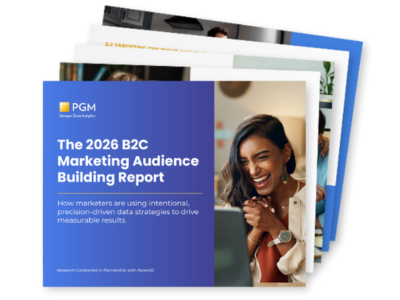Top Marketing Challenges
The report shines a light on some stubborn, and all too familiar, challenges that marketers face when trying to build effective audiences:
- More than half (57%) say they struggle to get the right data to personalize communications. Meaning even the most creative campaigns can fall flat if they’re not speaking to the right people in the right way.
- Nearly half (47%) are wrestling with the complexity of combining different data types and sources. It’s like you’re trying to piece together a puzzle when half the pieces are missing.
- 43% of marketers report difficulty in building the right segments. And if you can’t confidently define who you’re talking to, everything else becomes guesswork.
- 38% say they lack intent data, and 32% are still struggling to tap into valuable first-party insights. That’s a big deal.
These are huge roadblocks for your marketing campaigns because it’s incredibly hard to deliver the kind of personalized, high-impact experiences that today’s consumers expect without a strong data foundation.
How to Build High Impact Audiences in 2026
Let’s explore the six data elements that can help you overcome these challenges and build high impact audiences:

1.Having the correct data to personalize communications
Personalization isn’t optional anymore.
Today’s consumers don’t just appreciate tailored experiences—they actually expect them. When you craft an email or dynamic ad, the effectiveness hinges on one thing… having the right data at your fingertips.
And not just any data. The best marketers know it’s just not enough to greet someone by name or remember their last purchase, because true personalization digs deeper. You need to understand their behaviors, preferences, context, and timing. That’s what separates a “nice message” from a moment that actually resonates.
It’s no surprise that 57% of marketers say accurate, relevant data is the single most critical factor in building effective audiences.
Today’s marketing leaders are doing more than collecting data, they’re activating it with intent. They’re turning insights into action, and relevance into results.
PGM Tip: Want to get there? Start by cleaning house. Invest in data hygiene tools and validation processes. Because even the most brilliant personalization strategy will fall flat if it’s built on shaky data.
2. Having the correct contact info to reach across channels
If personalization is the message, cross-channel reach is the delivery.
High-performing strategies rely on what you say—but also where and how you say it. Today’s consumers move fluidly across different platforms, and they expect your brand to keep up with them.
But you can’t show up in the right place if your contact data is outdated or incomplete.
Nearly half of marketers (45%) say cross-channel reach is essential to their strategy—yet 40% still struggle with missing or inaccurate contact data.
If you want to meet your audience where they are—not just where it’s convenient for you—you need to get serious about the accuracy and depth of your data.
PGM Tip: Leverage enrichment tools and trusted third-party sources to fill in the blanks and keep your contact data accurate. Clean and connected data makes consistent, cross-channel engagement actually work.
3. Combining data types and sources
You no longer have to, or should be, relying on a single data source.
Today’s top-performing marketers are using a mix of first-party, second-party, third-party, and zero-party data to build a complete audience view.
In fact, those who layer intent data on top of first-party data report stronger outcomes in personalization (34% vs 22%), acquisition (37% vs 28%), and customer experience (42% vs 33%)
PGM Tip: You’ll want to diversify your data and prioritize those real-time, actionable insights.
4. Accessing first-party insights
First-party data is the foundation of audience building. It’s owned, reliable, and increasingly valuable- especially with privacy being a constant concern.
But only 49% of marketers with effective data strategies prioritize first-party insights, even though it’s essential for segmentation and personalization.
The benefits are evolving, too. While customer experience remains important, targeting accuracy and campaign optimization are gaining ground as top benefits of first-party data.
PGM tip: If you focus on collecting behavioral data from your website, email, and mobile apps- you can use it to refine your audience segments.
5. Accessing intent data
Let’s consider intent data to be the secret ingredient for predictive marketing.
And it’s gaining traction—36% of marketers now report significant use of intent data, up from 29% last year.
It’s great knowing who your audience is but imagine tapping into what they’re likely to do next. Think of the relevance you could add to your outreach efforts; showing up for them just as they’re most likely to need exactly what you have to offer.
PGM Tip: Layer third-party behavioral and purchase intent signals with your existing data to sharpen targeting.
6. Being able to build the right segments
Segmentation is where strategy meets execution.
And while 45% of marketers say they can segment to deliver personalized messaging, more than half still struggle with deeper personalization.
Segmentation is the difference between having great data and actually using it to drive personalized, high-performing campaigns.
Several challenges that marketers face when trying to build effective segments:
- Missing or inaccurate contact data (40%)
- Difficulty accessing the right data to form a full customer view (40%)
- Measuring segment performance (38%)
- Data spread across multiple channels (34%)
- Lack of resources or knowledge (33%)
These hurdles make it tough to move into the kind of dynamic, personalized targeting that drives results.
PGM Tip: You should use a combination of manual and automated segmentation to balance precision with scale. And don’t forget to measure segment performance to refine your strategy over time.
Final Thoughts
To build your audience in 2026, you have to go beyond just collecting data and start using it with purpose.
The marketers who are winning today are those who:
- Prioritize clean, actionable data
- Diversify their data sources
- Layer intent signals with first-party insights
- Build segments that drive personalization and performance
As privacy regulations continue to shift and platforms evolve, the report shows that you need to diversify your data strategy, in order to be better equipped to handle change and future-proof your work.





